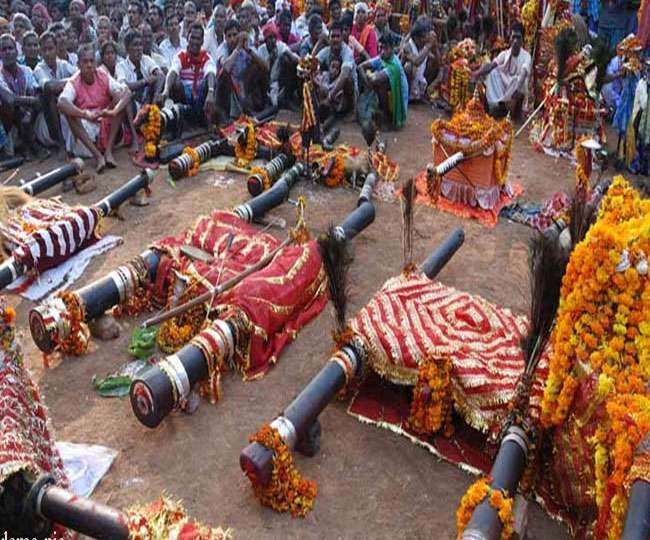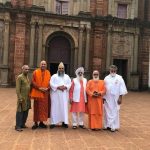Bastar Dussehra – Longest Festival Celebrations
Bastar is celebrated in Dandakarnya, where Lord Rama is believed to have spent the 14 years of his exile. Bastar Dussehra spans over 75 days starting around August and ending at October. It is thus the longest Dussehra celebrations in the world.

It involves the participation of diverse tribes and castes. The festival involves rituals of extraordinary rigour like a girl swinging on a bed of thorns; a youth (jogi) sitting in vigil, buried shoulder-deep, for nine days etc.
The festival provides a forum for elected representatives, administrators and tribal chieftains to make an address speach. One of the most awaited events is the rath yatra. It is made new each year using tribal tools and methods and sight of 400 persons pulling a large chariot is an experience by itself.
Bastar Dussehra : Tribals Beliefs
Bastar Dussehra is deeply influenced by the local myths and religious beliefs and the customs of the tribals.
Every year Bastar witnesses a 75 days long extravaganza of indigenous tribal customs and celebration of nature in the heartland of Chhattisgarh. The splendid display of devotion to Danteshwari Devi, the chief deity of Bastar is performed with warmth and gaiety.

In Hindu tradition, the festival of Dussehra is linked to Lord Rama’s victory over Ravana in the North and Durga Puja marks the triumph of Goddess Durga over Mahisasura in the East. But Bastar Dussehra has no relation to the above mentioned festivals.
History of Bastar Dussehra
As per legends, Goddess Danteshwari protected the king from his enemies. To honour her, every year each tribe is given a specific task for Dussehra which they complete with the blessings of ‘Anga Dev’ (local deity). Anga Dev is a representation of animist traditions and is shown in the form of a wooden palanquin.
It has also been said that Maharaja Kakatiya Purushottam Deo walked for almost a year to reach Jagannath temple in Puri. Jagannath was so happy by this gesture that he gifted a chariot to the Maharaja for his return journey. Every year that chariot takes a round of Jagdalpur during Bastar Dussehra.
Around 1400 BC, when the Bastar Dussehra started it used to be held for only 9 days and took place at Chhota Dongar [hillock area]. During those days, the main challenge was the pulling of the chariot as the downhill slope crushed many people. The venue of the festival changed many a times in the past, from Barsoor, to Tarlaguda, to Dantewada to Chhota Dongar before finally settling for Jagdalpur.

The origin of Bastar Dussehra dates back to 15th century AD, when the Kaktiya ruler King Purushottam Deo went to Jagannath Puri temple for worship and came back as ‘Rath-pati’ with a divine permission to mount on chariot. Since then, Dussehra is being celebrated by people of Bastar in this unique way.
Mixture of Myth and Tribal Culture
The festival brings a great deal of ardour and enthusiasm among locals, irrespective of their caste. All presiding deities from chota mandirs around Bastar travel to district headquarters of Jagdalpur. Orissa’s Saoras build the Dussehra rath that transports the deity.
The Dhakada tribe supervises its construction. The Khaki tribe worships the rath before it is used. The Parja provide ropes to pull the chariot, while Maria and Dhurwa tribes pull the Dussehra rath made of wood.

Few of the important ritual that are performed in 75 days:
Pata Jatra: This marks the starting of Bastar Dussehra, a log of wood called ‘Turlu Khotla’ is worshipped at Danteshwari Devi temple on the auspious day of Haryali Amavasya. This piece of wood is kept in front of the Goddess and blessings are given to it along with other instruments and construction material used for the chariot. Animal sacrifice also takes place to invoke the blessings of the Goddess.
Kaachangudi: A young girl is chosen from the local tribal community and she is made to sit on the ‘Swing of Thorns’ to appease Danteshwari Devi. The girl then relays the wishes of the Goddess and permits the commencement of Dussehra festivities.
Navaratra Dussehra: Priests offer prayers to the Goddess and ‘Kalash Sthapna’ is done to fade off evil spirits and start the festivities on a propitious note.
Jogi Bithai: A person from the Muria tribe is assigned with the task of fasting for 9 days. The man is asked to sit in a pit for the designated days and pray to the Goddess for smooth functioning of the Bastar Dussehra.
Phool Jatra: Starting from the 2nd to 7th day of Dussehra, the Rath goes on a parikrama from Maawali Mata Temple to Jagannath Temple at Sirasaar. The opulent look of the Rath adds up to its grandeur.
Nisha Jatra: Nisha Jatra is a ritual performed by the Maharaja and the priests of Danteshwari temple come to worship the arms of the goddess Danteshwari and then twelve men of the community bring offerings in earthen pots. Followed by animal sacrifice of 11 goats to appease the Goddess.
Jogi Uthaai: On Navami, at Sirasaar chowk the formalities of Jogi Uthaai takes place where a Yogi from Halda tribe breaks his 9 days fast. On the same day, the Doli [chariot] comes from Dantewada on a palanquin to Jagdalpur and is welcomed in the form of Maawali mata.
Bheetar Raini: On the occasion of Vijyadashami, the 8 wheeled chariot of Danteshwari Devi takes the predefined route round Maawali Mata Temple. During the procession, villagers from various tribes carry Anga Deo on their shoulders and go into a state of trance. The sound of drums and mahori along with influence of Mahua [local drink] fills the air with hypnotic spell and suspended animation.
Baahar Raini: On Ekadashi, the chariot is brought back to the royal palace after the negotiations with the King. The king offers rice from the new harvest to the Goddess and brings back his pride to Jagdalpur. The procession is infused with high energy and a lot of dancing and singing from the tribes takes place.
Kachan Jatra: This ceremony is observed to bid farewell to Kachan Devi. During this ceremony, animal sacrifices are done and Kachan Devi is worshipped with solemn customs. Also, on the same day Muriya Durbar takes place where in the elders from all the tribes meet the King to discuss impending issues concerning the region.
Kutumb Jatra: Anga Dev from nearby villages are bid adieu and send back to their own places along with their priests. This ceremony marks the end of the grand Bastar Dussehra.
@religionworldin
[video_ads]









